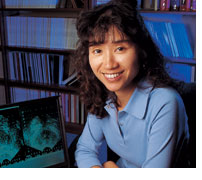Seeds sown with precision
Precision
is everything in prostate cancer treatment. Without it, incontinence and
impotence can wreak havoc on a patient’s quality of life.
A new technology
developed by an Emory researcher makes prostate brachytherapy more precise.
In brachytherapy, radioactive seeds are placed strategically in the cancerous
prostate to deliver radiation continuously.
 Eva
K. Lee (left), a professor of radiation oncology at Emory and industrial
and systems engineering at Georgia Tech, has developed a computerized
expert system to help radiation oncologists optimize seed placement. In
prostate brachytherapy, the radiation dose must be carefully designed,
balancing the high radiation levels needed to eradicate the cancer against
the need to protect nearby tissue, including the urethra and rectum. Physicians
must also consider edema that occurs as needles are inserted to place
the seeds. Edema can change prostate volume so that too little radiation
is delivered early in treatment and too much as swelling subsides.
Eva
K. Lee (left), a professor of radiation oncology at Emory and industrial
and systems engineering at Georgia Tech, has developed a computerized
expert system to help radiation oncologists optimize seed placement. In
prostate brachytherapy, the radiation dose must be carefully designed,
balancing the high radiation levels needed to eradicate the cancer against
the need to protect nearby tissue, including the urethra and rectum. Physicians
must also consider edema that occurs as needles are inserted to place
the seeds. Edema can change prostate volume so that too little radiation
is delivered early in treatment and too much as swelling subsides.
Precisely
tailored to each patient, Lee’s system targets escalated doses of
radiation at tumor pockets and accounts for changes in prostate volume
during treatment. The system uses ultrasound images of the patient’s
prostate, mixed-integer programming, and computational optimization to
determine the best radioactive seed placement. It cuts the time needed
to plan seed placement from several hours to about 15 minutes. It also
gives less experienced oncologists or those in remote areas the ability
to offer high-quality treatments.
“For
physicians, this will be a black box," says Lee. "They will
not need to know what is going on with the mathematics. All they will
have to do is tell the system what they want in the plan.”
The system is being tested for clinical use and should be available to treatment centers soon, says Lee. (BACK TO TOP)
 Higher-tech
imagery
Higher-tech
imagery Emory is
one of only three sites in the United States to receive a new combination
scanner to diagnose cancer.
The scanner fuses positron emission tomography and computerized tomography
information to help pinpoint and localize cancerous tumors faster and
more accurately than with previously available imaging technology.
Created by GE Medical Systems, this combined scanner should arrive at Emory this summer. “This new system will reduce invasive procedures as well as examination and imaging time,” says William Casarella, chair of radiology. (BACK TO TOP)
Copyright © Emory
University, 2004. All Rights Reserved